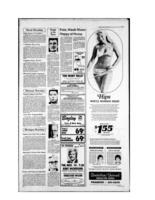-

-
Interview with Robert Goodvoice
-
-Description taken from “Interview with Robert Goodvoice”-
He gives an account of the Sioux participation in the War of 1812 on the side of the British, and the Sioux interpretation of the reward promised them by the British Crown; tells the history and whereabouts of the King George III medals given to the Sioux for their loyalty to the British Crown during the War of 1812; tells the story of two Sioux chiefs who were kidnapped in Manitoba and returned to the United States, presumably for their part in the 1862 Sioux uprising (Minnesota Massacre); tells of the dispersal of the Sioux in their flight from the U.S. army following the 1862 uprising; and a story of one family's search for their relations in the wake of this dispersal.
-

-
Invisible Women
-
-- Description taken from "Invisible Women"--
While there is some anecdotal reporting on Aboriginal involvement, current scholars
on WWII have overlooked the Indigenous experience both in combat and on the homefront when examining the ‘national’ experience. However, in recent years, due to more Native history being written, there is some new research on Aboriginal peoples in WWII,
but mainly the Aboriginal male experience. There is practically nothing written about the Aboriginal female experience. Where are their voices? What are their stories? The objective of this research is to record, share, and analyze the stories and experiences of
Aboriginal servicewomen in Canada’s WWII. How did their experiences compare to those servicewomen of non-Aboriginal ancestry? Since there was no previous investigation of this topic, there was no foundation upon which to build. This thesis
draws on oral histories and some textual/visual documentation to answer these questions.
-

-
Joe McKay
-
A photo of Joe McKay., The man beside Joe McKay is not Chief Mistawasis.
-

-
Lansing State Journal November 18, 1947
-
In this newspaper clipping by the Lansing State Journal, it says how seven children died in a fire. The police say that the babysitter left the children at home because she thought the mother would soon return. The fire was started when the mattress had caught on fire. It is said that the three children, aged from 3 months to 4 ½ years old, had died from asphyxiation. The article goes on to explain what time the fire started and when the children were found.
-

-
Logansport Pharos Tribune, August 5,1920
-
In this newspaper clipping from Logansport Pharos, they mention how the war veterans are getting paid by the Canadian Government by the use of land and farms. The area that these soldiers are getting is from First Nations Communities. The article then goes on to take about how many acres were sold and for how much they were sold by.
-

-
Losing the Game
-
--Description taken from "Losing the Game"--
This thesis examines the historical dynamics around how First Nations hunters came to be regulated in Alberta in the period around the turn of the century. Alberta, before it gained provincial status, was part of the North West Territories, which passed their own game regulations. After 1905, Alberta passed its own game laws. During this whole period, local sportsmen lobbied for local game laws to apply to First Nations. Was conservation of game the only impetus for the creation of game laws in Alberta? Or, were their other values being supported by game laws and their enforcement?
The importance of hunting to two different cultures resulted in a conflict over scarce wildlife resources. Sportsmen's values won out over the values placed on wildlife by First Nations. The law and policy with respect to hunting reflected the sportsmen's values and eventually saw First Nations hunters come under, first territorial, and later provincial, game laws notwithstanding the fact that First Nations fell under the exclusive jurisdiction of the Dominion Government and the fact that First Nations had entered into treaties under which they were assured that their traditional livelihoods would be protected.
-

-
Manitoba Free Press February 9, 1886
-
The Manitoba press reports talk about the missions the reverends of the Presbyterian Church are doing at First Nation Communities. The article then goes on to talk about the different reverends, where they are located and what they’re doing.
-

-
Manitoba Free Press, February 12, 1891
-
In this newspaper clipping from the Manitoba Free Press, the newspaper included parts of reports from Indian Agents that say what had happened from their agencies.
-

-
Mediating the Numbered Treaties
-
--Description taken from "Mediating the Numbered Treaties:Eyewitness Accounts of Treaties Between the Crown and Indigenous People, 1871-1856"--
This thesis looks at the historical period of treaty-making in Western Canada when six numbered treaties were negotiated between Canada and the Anishnabeg, Cree, Saulteaux, and Assiniboine Nations between 1871 and 1876. The main interpretation of treaty-making during this period is that the treaty commissioners and Indigenous leadership experienced “cultural misunderstandings” and thatEuro-Canadian witnesses to treaty did not understand thetreaty relationship. As a result, most of the eyewitness accounts by Euro-Canadian fur traders, missionaries, journalists, settlers and government representatives have been ignored by historians. This thesis argues against cultural misunderstandings and shows that Euro-Canadian negotiators and eyewitnesses clearly understood the roles and responsibilities in the treaty relationship. Violations of treaty did occur as new settlers moved into treaty territory and government representatives became more concerned about financial restrictions than the promises made during the negotiations.However, during the treaty-making period,Euro-Canadians understoodtheir obligations under the treaty relationship. This thesis analyzes previously under-utilizedprimary documents and re-evaluates standard sources on the numbered treaties to show that during the treaty-making period, Euro-Canadians understood the expectations of Indigenous peoples in the treaty relationship.


